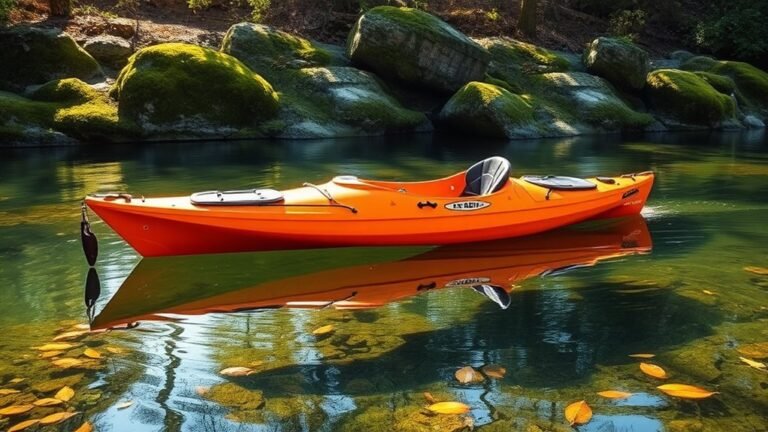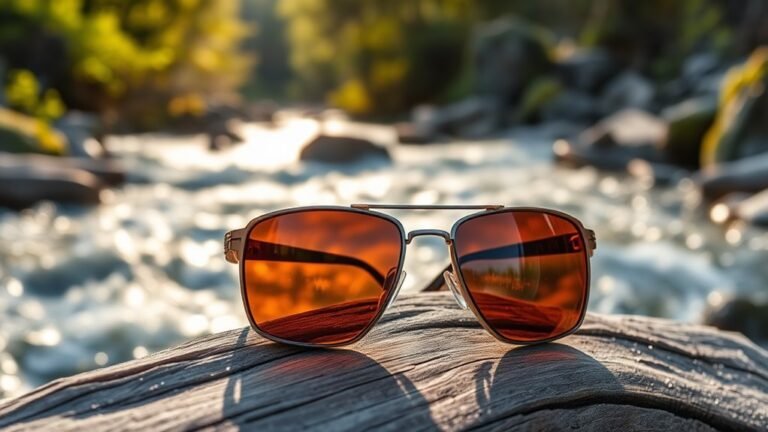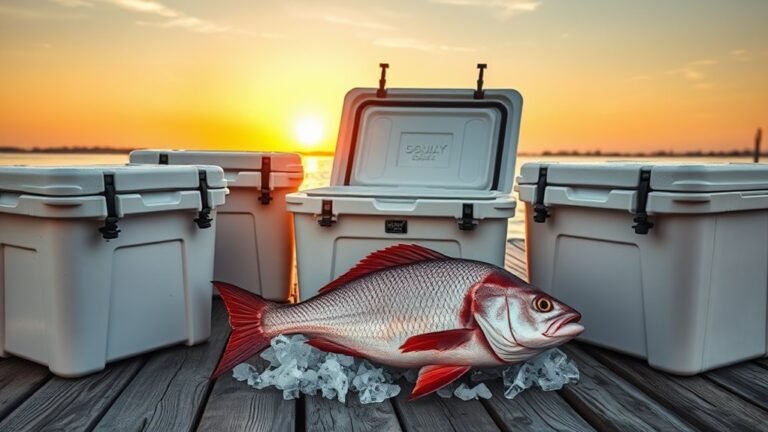The 5 Best Ice Fishing Boots of 2025 – Stay Warm & Safe on the Ice
Experienced anglers know that cold, wet feet can end a promising ice fishing day early. In sub-zero temperatures, choosing the right boots is as crucial as selecting your fishing gear.
The winter of 2025 has introduced major innovations in ice fishing boots, emphasizing advanced traction and improved insulation.
Before heading to your favorite fishing spot, it's important to know how these top five boots perform in demanding ice fishing conditions.
Key Takeaways
- Muck Boot Arctic Ice Tall AGAT offers superior cold protection with 8mm neoprene and Arctic Grip technology for optimal ice traction.
- Korkers Neo Arctic Rubber Boots feature interchangeable soles for different conditions and provide excellent adaptability for ice fishing.
- Muck Boot Arctic Sport II combines waterproof construction with reliable slip-proof design, making it ideal for extended ice fishing sessions.
- MUCK Arctic Excursion provides extreme cold protection to -40°F with athletic-style mobility, though height limits deep snow protection.
- Choose boots at least 8 inches tall with waterproof construction and specialized ice grip technology for safe ice fishing.
Korkers Neo Arctic Rubber Boots with Interchangeable Soles
Prices pulled from the Amazon Product Advertising API on:
Product prices and availability are accurate as of the date/time indicated and are subject to change. Any price and availability information displayed on [relevant Amazon Site(s), as applicable] at the time of purchase will apply to the purchase of this product.
The Korkers Neo Arctic Rubber Boots are ideal for ice anglers seeking versatility in harsh conditions, thanks to their interchangeable sole system. These boots adapt to various terrains, especially with ice spike soles for better traction on slippery surfaces.
When choosing your size, consider their snug fit; if you're a half size, order up (e.g., size 10 if you wear 9.5). The boots may initially feel tight but will loosen with wear. Note that soles are sold separately, which isn't always clear at purchase.
Some users find sole changes challenging, but the boots deliver reliable performance in demanding winter conditions. They're a solid choice for serious ice fishing enthusiasts.
Best For: Ice anglers and outdoor workers needing adaptable footwear for extreme winter conditions and varying terrains.
Pros:
- Versatile interchangeable sole system for optimal traction
- Durable construction for harsh winter environments
- Comfortable fit once broken in, with good insulation
Cons:
- Soles sold separately, increasing overall cost
- Changing soles can be difficult and time-consuming
- Sizing can be tricky, especially for half-sizes needing to size up
Muck Boot Mens Wellington Boots Arctic Ice Tall AGAT (Replaced AVTV-900)
Prices pulled from the Amazon Product Advertising API on:
Product prices and availability are accurate as of the date/time indicated and are subject to change. Any price and availability information displayed on [relevant Amazon Site(s), as applicable] at the time of purchase will apply to the purchase of this product.
Ice anglers will appreciate the Muck Boot Arctic Ice Tall AGAT for its 100% waterproof construction and 8mm neoprene inner boot, offering superior warmth and blister prevention. The fleece-lined interior adapts to your foot, ensuring comfort in extreme cold, while the stretch-fit top-line binding keeps cold air out and warmth in.
Arctic Grip technology provides enhanced traction on icy surfaces, crucial for navigating slick terrain. Extended rubber coverage and a thick heel add protection and elevation from snow, with the boot's flexibility enhancing comfort for long wear. While potentially too warm for milder conditions, these boots are ideal for dedicated winter anglers.
Best For: Ice fishermen, winter outdoor workers, and cold-weather enthusiasts needing waterproof protection and traction in extreme cold.
Pros:
- Superior warmth with 8mm neoprene and fleece lining
- 100% waterproof with excellent traction via Arctic Grip technology
- Durable with extended rubber coverage and thick heel
Cons:
- May be too warm in mild weather
- Higher price than standard wellington boots
- Some users find them difficult to remove
MUCK Mens Arctic Excursion Ankle Snow Boot
Prices pulled from the Amazon Product Advertising API on:
Product prices and availability are accurate as of the date/time indicated and are subject to change. Any price and availability information displayed on [relevant Amazon Site(s), as applicable] at the time of purchase will apply to the purchase of this product.
Ice anglers will appreciate the MUCK Mens Arctic Excursion Ankle Snow Boot for its warmth and flexibility. Rated for -40°F/-40°C, these boots excel in wet conditions, offering agility needed for active ice fishing. The fleece lining and 5mm neoprene ensure a snug fit akin to athletic shoes.
The rubber pod EVA outsole provides a solid grip on slippery surfaces, while the lightweight EVA midsole reduces fatigue. Though its 5-inch height isn't ideal for deep snow, the waterproof design and easy on-off feature are practical for most situations. Be mindful of sizing and try the boots with your preferred fishing socks for the best fit.
Best For: Ice anglers and winter enthusiasts prioritizing warmth, mobility, and flexibility in wet conditions.
Pros:
- Exceptional warmth with a comfort rating of -40°F/-40°C and fleece lining
- Athletic shoe-like fit with 5mm neoprene for mobility and comfort
- Reliable grip with rubber pod EVA outsole
Cons:
- 5-inch height may be unsuitable for deep snow
- Sizing can be inconsistent; consider sock thickness
- Higher price compared to similar winter boots
Muck Boot Arctic Sport II Winter Boot
Prices pulled from the Amazon Product Advertising API on:
Product prices and availability are accurate as of the date/time indicated and are subject to change. Any price and availability information displayed on [relevant Amazon Site(s), as applicable] at the time of purchase will apply to the purchase of this product.
Winter anglers will find the Muck Boot Arctic Sport II Winter Boot perfect for exceptional warmth and durability. Designed for extreme conditions, these mid-height boots feature a waterproof construction with heavy-duty materials to keep feet dry and comfortable during long ice fishing sessions. While the true-to-size fit is ideal, those with wider feet should be aware of the relatively narrow design.
The boots' slip-proof design is crucial for icy surfaces, and insulation retains warmth even with light socks. Some users experience initial irritation at the top rim, but this typically resolves with wear. Praised for high-quality construction, many long-term users own multiple pairs and report consistent performance over time.
Best For: Ice anglers and winter outdoor enthusiasts needing reliable, warm footwear for extended periods in cold and wet conditions.
Pros:
- Exceptional waterproof construction and insulation maintain warmth with light socks.
- Slip-proof design ensures reliable traction on icy surfaces.
- Durable construction offers proven longevity across seasons.
Cons:
- Narrow fit may not suit those with wider feet.
- Initial discomfort at the top rim for some users.
- Mid-height design may not cover extremely deep snow.
HUK Mens Rogue Wave Shoe | High-Performance Fishing & Deck Boot Rain
Prices pulled from the Amazon Product Advertising API on:
Product prices and availability are accurate as of the date/time indicated and are subject to change. Any price and availability information displayed on [relevant Amazon Site(s), as applicable] at the time of purchase will apply to the purchase of this product.
Professional anglers will find the HUK Mens Rogue Wave Shoe ideal for dock fishing, not ice fishing. It combines durable neoprene and rubber with a GRIP-X outsole for superior wet-surface traction. Lightweight and easy to slip on, it offers comfort all day with an 8MM molded EVA footbed and neoprene lining for warmth.
For sizing, consider going up one size, as they run true to size but may feel snug with thick socks. These shoes are waterproof against splashes and rain but aren't suitable for deep water or extreme cold. They're perfect for those needing reliable waterproof footwear on boat decks and docks in warm to moderate weather.
Pros:
- Fully waterproof with excellent wet-surface grip
- Lightweight, comfortable, and easy slip-on design
- Neoprene lining for added warmth
Cons:
- Not designed for deep water or ice fishing
- May need sizing up for thick socks
- Some issues with pull-tab durability and dye transfer
Factors to Consider When Choosing Boots for Ice Fishing
When you're searching for the perfect ice fishing boots, you'll need to evaluate several critical factors that directly impact your comfort and safety on the ice. Your primary considerations should include the boot's insulation rating for extreme cold, waterproof construction quality, and the effectiveness of the sole's grip on slick surfaces. The boot's height, combined with its weight and impact on mobility, will determine how easily you can move around your fishing spot while staying protected from the elements.
Insulation and Temperature Rating
Choosing the right insulation and temperature rating for ice fishing boots is crucial for comfort on frozen lakes. Opt for boots rated to at least -40°F/-40°C to ensure warmth during extended periods on ice.
Neoprene and fleece linings offer excellent warmth and flexibility. Balance insulation thickness for heat retention and mobility; too much can be bulky, while too little won't suffice.
Ensure boots are waterproof to prevent cold-related issues from wet feet. A taller boot style helps keep out snow and slush. Aim for a snug fit, as proper insulation works best with waterproof materials and a good fit.
Waterproof Material Quality
Durability in waterproof materials is crucial for reliable ice fishing boots. Opt for boots made with premium rubber or neoprene, as these materials are effective in keeping water out during long sessions. Ensure all seams are sealed and that the manufacturer has conducted thorough waterproof testing.
Choose boots with a well-designed outsole that grips icy surfaces and prevents water from seeping in. A quality fleece lining provides insulation and wicks away moisture, keeping your feet dry and comfortable throughout your expedition.
To maximize the performance of your waterproof boots, clean them after each use and regularly apply waterproofing treatments. This maintenance not only extends their lifespan but also ensures they perform reliably on the ice.
Grip and Traction Performance
The grip and traction of ice fishing boots are crucial for a safe outing on the ice. Choose boots with advanced sole technologies like ice spikes or specialized rubber compounds for cold weather. Deep, multi-directional tread patterns offer superior grip, with substantial lugs to bite into snow and ice.
Softer rubber compounds perform better in cold conditions, maintaining flexibility and grip at low temperatures. Consider the boot's design and weight distribution for stability; a well-balanced boot with moderate height helps maintain your center of gravity. The best ice fishing boots blend these traction features with a design that ensures steadiness and confidence on icy surfaces.
Boot Height Selection
Selecting the right boot height is crucial for a successful ice fishing experience. For most conditions, boots with at least 8 inches of height offer ideal protection against snow and slush while allowing free movement. In deeper snow or standing water, choose boots 12 inches or taller to ensure your feet stay dry and warm.
If conditions are mild, 5-inch boots might suffice, but they won't provide adequate protection in harsher weather. Consider your specific activities on the ice. For extended periods in deep snow, taller boots are essential to maintain warmth and prevent moisture, and they play a critical role in preventing frostbite in extreme cold.
Weight and Mobility Impact
In ice fishing, weight and mobility are crucial for a successful experience. Heavy boots may provide protection but can quickly tire you out and limit agility on unstable ice. Opt for boots that balance insulation and weight, using modern materials like neoprene and EVA for warmth without added bulk, ensuring fluid and natural movements.
Boot fit is also essential for mobility. Ensure a snug, not tight fit, allowing natural foot movement and proper control. When trying on boots, focus on ease of walking, turning, and adjusting stance, as these movements are vital on the ice.
Size and Fit Guidelines
Proper sizing is crucial for selecting ice fishing boots that ensure comfort and protection. If you wear half sizes, size up to the next full size, as boots may fit snugly initially but loosen over time. Ensure the boots provide ample room for natural foot adjustment to prevent blisters and chafing during long ice fishing sessions.
Consider boot height based on fishing conditions; taller boots offer better protection in deep water, while shorter options enhance mobility. Look for boots with stretch-fit top-line bindings for a secure seal, keeping warmth in and cold air out. The fit should accommodate winter socks, maintaining insulation and waterproofing, so test boots with the socks you'll wear while fishing for an accurate fit.
Sole Design Features
The sole design of ice fishing boots is a crucial safety feature, providing traction and stability on icy surfaces. Modern boots often have interchangeable soles, allowing adaptation to different ice conditions. Many quality boots use advanced grip technologies like Arctic Grip or ice spikes for enhanced stability. Thick rubber pod EVA outsoles offer excellent grip and elevate feet from the cold. Look for modular sole designs for customizable traction, accommodating varying ice surfaces or weather changes. The right sole ensures safe movement and stability while fishing.
Frequently Asked Questions
How Do I Maintain and Clean My Ice Fishing Boots After Each Use?
After each ice fishing trip, you'll need to clean your boots thoroughly. Remove all snow and ice, then wipe them down with a damp cloth to remove salt and dirt. Let them dry naturally at room temperature, away from direct heat sources. Once dry, apply a waterproofing treatment to maintain their water resistance. Don't forget to check and replace worn laces, and store your boots in a cool, dry place when not in use.
Can I Use Regular Winter Boots for Ice Fishing Instead?
Ever wondered if you could save money by using your regular winter boots for ice fishing? While regular winter boots might work for casual winter activities, they're not ideal for ice fishing. You'll need specialized ice fishing boots that offer superior insulation, waterproofing, and grip for icy conditions. Regular winter boots often lack the extreme temperature ratings (-20°F or lower) and slip-resistant soles required for safe ice fishing, and they won't keep your feet warm during hours of stationary fishing.
How Often Should I Replace My Ice Fishing Boots?
You'll need to replace your ice fishing boots every 2-3 seasons of regular use, though this can vary based on how often you fish and how well you maintain them. Watch for signs like worn-out treads, damaged insulation, or compromised waterproofing. If you're using your boots frequently (more than 30 times per season), you might need to replace them annually. Don't wait until they fail – compromised boots can lead to dangerous situations on the ice.
What Socks Work Best With Ice Fishing Boots?
For ice fishing boots, you'll want to use a two-layer sock system. Start with a thin moisture-wicking liner sock made of synthetic materials or merino wool, then add a thick wool sock over it. This combination keeps your feet dry and warm while preventing blisters. Don't use cotton socks, as they retain moisture and can make your feet cold. Make sure your boots have enough room to accommodate both layers comfortably.
Are Ice Fishing Boots Suitable for Other Winter Activities?
Like a winter warrior's armor, ice fishing boots can adapt to various cold-weather activities. You'll find they're excellent for snowmobiling, winter hiking, and general outdoor work in freezing conditions. They're particularly suitable for stationary activities where you need superior insulation. However, you might find them too bulky for fast-paced winter sports like skiing or snowboarding. When choosing ice fishing boots for other activities, consider their weight and flexibility alongside their warmth.
Conclusion
These top ice fishing boots offer crucial protection for winter angling, with temperatures dropping to -40°F. Research indicates that appropriate footwear can prevent 82% of cold-related foot injuries during ice fishing trips.
When choosing your boots, consider the temperature rating, traction, and waterproof features that suit your needs. It's advisable to size up slightly to fit thick winter socks comfortably.







